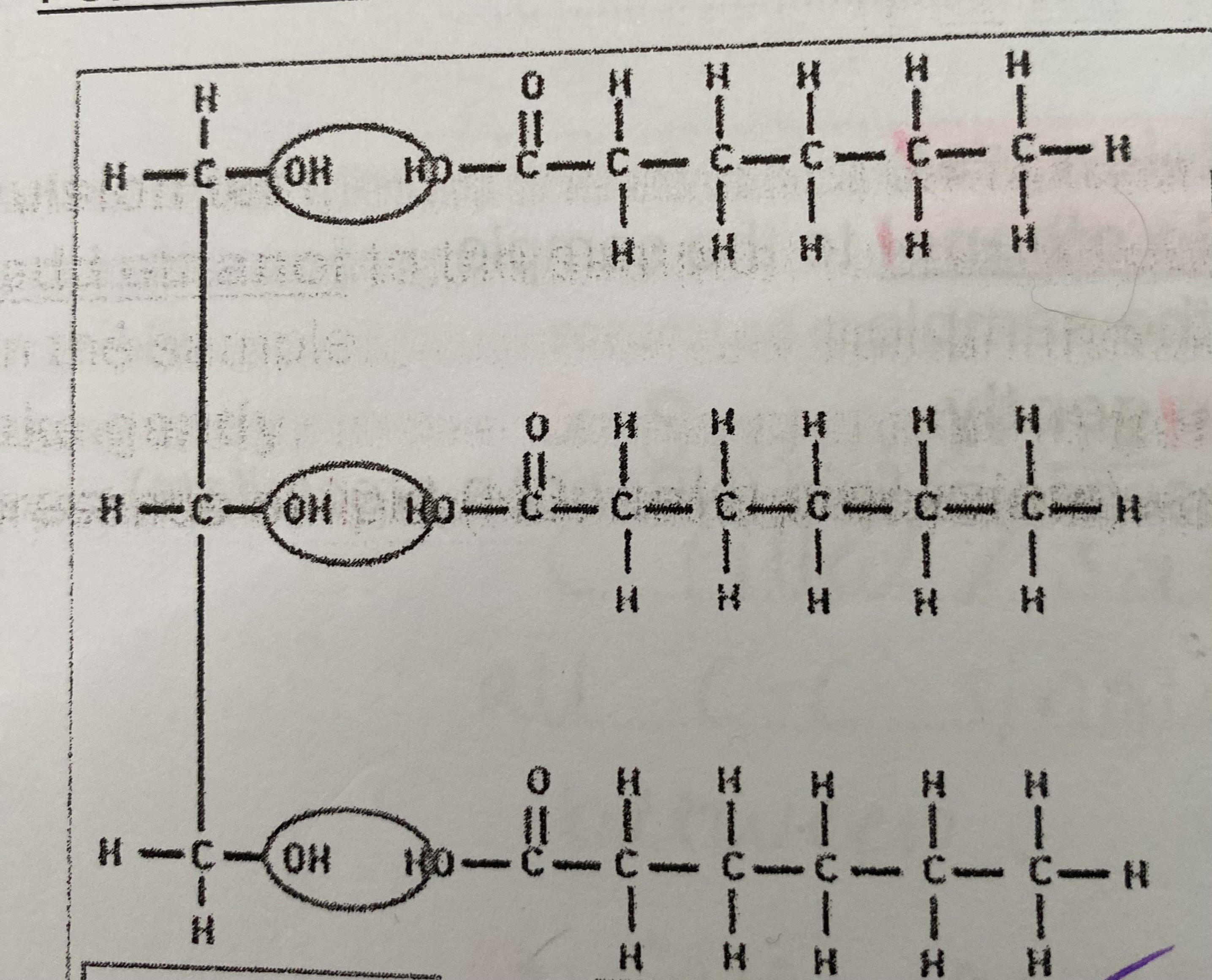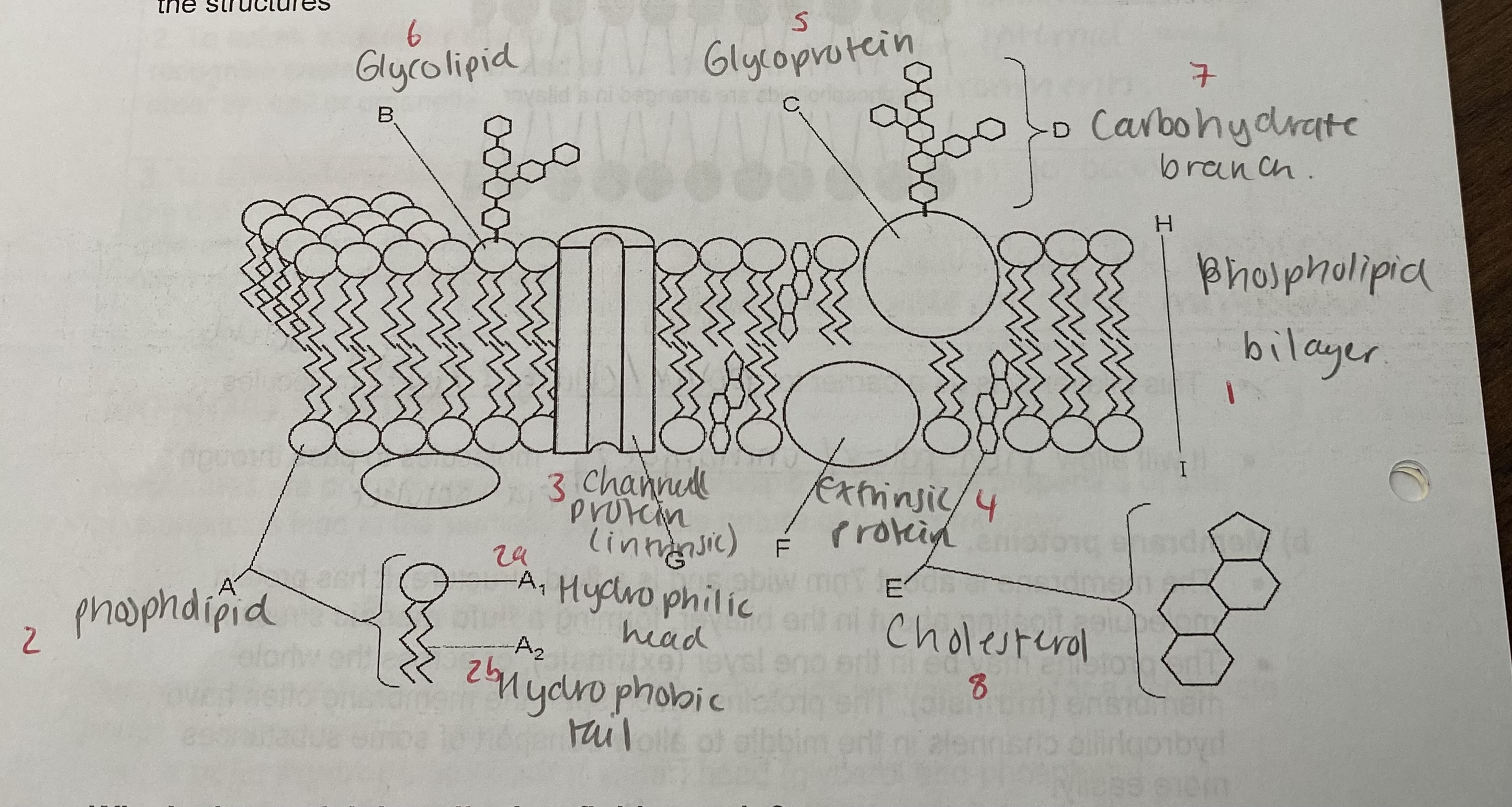3- Lipids, Membranes and Transport
1/69
There's no tags or description
Looks like no tags are added yet.
Name | Mastery | Learn | Test | Matching | Spaced |
|---|
No study sessions yet.
70 Terms
What elements are lipids made from?
carbon
oxygen
hydrogen
What are lipids?
large and varied group of non-polar molecules that are insoluble in water but dissolve easily in organic solvents
What is a triglyceride?
3 fatty acids and 1 glycerol molecule held together with ester bonds
What is a saturated fatty acid?
no double bonds between carbon atoms

What is an unsaturated fatty acid?
1 or more double bonds between carbon atoms

What is glycerol?
3 hydroxyl groups

How is a triglycerol formed?
Glycerol is bonded with 3 fatty acids and removes 3 water molecules during condensation reactions to get a triglyceride held with ester bonds between the OH of glycerol and COOH of fatty acids

Why are triglycerides not classed as polymers?
made from 2 different types of molecules
What are the biological roles of triglycerides?
storage of energy
insulation (electrical + heat)
protection
What are the structures and properties of triglycerides and how do they relate to their function?
High ratio of energy storing carbon-hydrogen bonds to carbon atoms= excellent source of energy
Low mass to energy ratio= good storage molecules as much energy can be stored in a small volume
Large, non-polar molecules and insoluble in water= no osmotic effect and do not affect the water potential in cells
What is the difference between a triglyceride and a phospholipid?
TRIGLYCERIDE:
glycerol
3 fatty acids
PHOSPHOLIPID:
phosphate head
2 fatty acid tails
What is the food test for lipids?
add ethanol to sample
shake
add water
shake gently
milky white emulsion indicates presence of lipid
What are the 3 main functions of plasma membranes?
to control transport of substances into/out of cell or organelles
to act as a receptor site to recognise chemicals which need to enter the cell/organelle
to compartmentalise, separate off the cell from environment, and the different reactions of the cell from each other by forming organelles
Why is control of transport of substances important for plasma membranes?
allow certain molecules to pass through, but not others (partially permeable)—> O2, C6H12O6, H20, CO2
Why is acting as a receptor site important for plasma membranes?
allows cells to communicate and react to their internal and external environments
Why is compartmentalisation important for plasma membranes?
allows reactions to occur more efficiently
different concs can be maintained on either side of the membrane
What is the membrane structure?
primarily made from a phospholipid bilayer
What are phospholipids?
a polar/ hydrophilic (attracts water) head (glycerol + phosphate)
non-polar hydrophobic (repels water) tails (fatty acids)

How is the phospholipid bilayer structured?
hydrophobic tails all point towards each other
hydrophilic heads point out into the water
What is the function of the phospholipid bilayer?
separates the cytoplasm from the water outside
acts as a barrier to polar/ charged/ water-soluble molecules
allows non-polar/ uncharged/ lipid soluble molecules to pass through
What is the structure of the bilayer with proteins in it called?
fluid mosaic structure
What are the 2 types of proteins that are in the membrane called?
Intrinsic
Extrinsic
What is an intrinsic protein?
protein across the whole membrane
What is an extrinsic protein?
protein in 1 layer of the membrane
What is the function of the proteins in the membrane?
have hydrophilic channels to allow transport of some substances more easily
Which substances would be able to move through the hydrophilic channels of the proteins?
large, charged, polar, water soluble molecules
E.G.
glucose
sodium ions
amino acids
etc
What are the functions of intrinsic proteins?
transport= channel + carriers
What are the functions of extrinsic proteins?
enzymes
receptors= for binding to hormones
antigens= for cell recognition
What is a glycoprotein?
short, branching, carbohydrate chains attached to proteins in the membrane
What is the function of a glycoprotein?
act as receptors for hormones and neurotransmitters/ antigens
What is a glycolipid?
a carbohydrate covalently bonded to a lipid
What is the function of a glycolipid?
act as recognition sites
help maintain stability of membrane
help cells attach to one another to form tissues
What is cholesterol?
restricts movement of other molecules making up the membrane and increases strength and stability of membranes (makes them less flexible)
helps prevent loss of water and dissolved ions
What are the components of the fluid mosaic model?
phospholipid bilayer
phospholipid (hydrophilic head + hydrophobic tail)
channel protein (intrinsic)
extrinsic protein
glycoprotein
glycolipid
carbohydrate branch
cholesterol

Why is the model described as fluid mosaic?
FLUID= all different molecules can move around
MOSAIC= different types of molecules (proteins + carbohydrates ‘float around’ within the phospholipid bilayer)
This fluidity means that cells are able to change their shape
Explain the significance of protein-lined pores for simple diffusion
allows polar, water soluble molecules to move through
Explain the significance of small gaps between phospholipids for simple diffusion
allows small, lipid soluble molecules to diffuse
Explain the significance of phospholipid bilayer for simple diffusion
repels water soluble, charged and polar molecules
Explain the significance of intrinsic proteins for facilitated diffusion
movement of specific polar/ water soluble/ charged/ large molecules down a conc gradient
How does high water potential affect movement of water?
many free water molecules
How does lower water potential affect movement of water?
fewer free water molecules as there is an increase in solute conc. Water will move to this side of the membrane by osmosis
What are the ways of transport across membranes?
simple diffusion
facilitated diffusion
osmosis
active transport
Which processes of transport are passive?
diffusion and osmosis as they don’t require energy in the form of ATP
Which processes of transport are active?
active transport and endo/exocytosis as they require energy in the form of ATP
What is simple diffusion?
the net movement of molecules down a concentration gradient until equilibrium is reached
What type of ions cannot diffuse across a membrane?
charged particles/ ions
What are the factors that affect rate of diffusion?
surface area
thickness of exchange surface
concentration gradient
size of diffusing molecule
temperature
water solubility/ polarity
How does surface area affect rate of diffusion?
greater the SA= faster rate of diffusion
How does thickness of exchange surface affect rate of diffusion?
thinner the surface= faster rate of diffusion
How does concentration gradient affect rate of diffusion?
steeper the gradient= faster rate of diffusion
How does size of diffusing molecule affect rate of diffusion?
smaller diffusing molecule= faster rate of diffusion
How does temperature affect rate of diffusion?
higher temperature= faster rate of diffusion
How does water solubility/ polarity affect rate of diffusion?
non-polar molecules diffuse faster than polar ones (polar molecules have to go through a protein)
What is Fick’s law?
rate of diffusion ∝ (surface area x difference in conc) /
thickness of exchange surface
How do we increase diffusion rate according to Fick’s law?
increase SA + difference in conc
decrease thickness of exchange surface
Which molecules will be able to move through he phospholipid bilayer by simple diffusion and why?
Non-polar= diffuse rapidly across bilayer as are lipid soluble and not repelled by fatty acids in the hydrophobic tails
Smaller molecules= can fit between phospholipid molecules
Oxygen molecules= non-polar and small so diffuse rapidly through bilayer
What is facilitated diffusion?
simple diffusion with intrinsic proteins
down conc gradient by may be limited by number of carrier/channel proteins (levels off above certain conc because all proteins are occupied/ saturated)
passive
moves specific charged/ polar/ hydrophilic substances (channels= ions, carriers= others)
Which molecules will move by facilitated diffusion?
specific charged/ polar/ hydrophilic substances
fatty acids tails act as barrier to these molecules
e.g.
sodium ions, glucose, amino acids
What could increase rate of facilitated diffusion?
increase conc of channel proteins
steeper conc gradient
What is active transport?
Movement against a conc gradient which requires ATP and needs specific protein carriers
any factor that reduces rate of respiration will reduce active transport e.g. lack of oxygen/ glucose, low temp etc
roots take up ions by active transport
What can limit rate of active transport?
any factor that reduces rate of respiration
amount of carrier proteins
What is endocytosis?
taking products into cell
What is exocytosis?
releasing products out of cell
What are endocytosis + exocytosis used for?
transport of large amounts
cells make vesicles to transport solids/ liquids across the plasma membrane into/out of cell
importing material in vesicles= endocytosis
exporting material in vesicles= exocytosis
both require ATP
What is osmosis?
movement of water across a partially permeable membrane down a water potential gradient from higher (less negative) to lower (more negative) water potential
What is water potential measured in?
kPa
What is pure water’s water potential?
0 kPa
What water potential does any non pure water have?
negative
What water potential will a concentrated solution of solute (e.g. glucose) have?
lower water potential —> fewer water molecules free to move
Describe and explain the impact of additional solutes on water potential
the addition of solutes reduces the water potential of a solution by reducing the number of free water molecules (more are stuck/bound to the solute molecules)